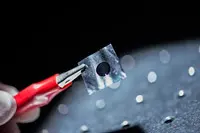 A team from Rice University, led by materials scientist Jun Lou, has created a novel cathode from nanotubes that were bonded to graphene.
A team from Rice University, led by materials scientist Jun Lou, has created a novel cathode from nanotubes that were bonded to graphene.
The method extends a stream of nanotechnology research carried out at Rice previously that began with the invention of a technique to grow very long bundles of aligned carbon nanotubes.
In this process, the nanotubes remained attached to the surface substrate but pushed the catalyst up as they grew.
The new cathode's charge transfer resistance, which determines how well electrons cross from the electrode to the electrolyte, was found to be 20 times smaller than for traditional platinum based cathodes, Lou said.
The key is in the hybrid's huge surface area, estimated at more than 2,000m2 per gram.
With no interruption in the atomic bonds between nanotubes and graphene, the material's entire area becomes one large surface. This gives the electrolyte plenty of opportunity to make contact and provides a highly conductive path for electrons.
Lou's lab built and tested solar cells with nanotube forests of varying lengths. The shortest, which measured between 20 to 25µ, were grown in just four minutes.
Other nanotube samples were grown for an hour and measured about 100 to 150µ. When combined with an iodide salt based electrolyte and an anode of flexible indium tin oxide, titanium dioxide and light capturing organic dye particles, the largest cells were only 350µ thick – the equivalent of about two sheets of paper – and could be flexed easily and repeatedly.
Tests found that solar cells made from the longest nanotubes produced the best results and topped out at nearly 18mA of current per square centimetre, compared with nearly 14mA for platinum based control cells.
In addition, the new dye sensitised solar cells were as much as 20% better at converting sunlight into power, with an efficiency of up to 8.2%, compared with 6.8% for the platinum based cells.
Author
Laura Hopperton
Source: www.newelectronics.co.uk

